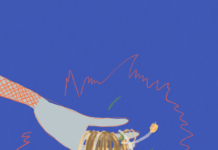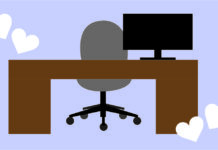The UW Art Gallery’s presentation of The Further Apart Things Seem is a magical and immersive representation of our changing world. This exhibit is on display at the UW Art Gallery until Dec. 10 and features the work of various artists, all of whom bring something new and refreshing to the show, shedding light on different political, social and interpersonal conflicts and experiences.
Walking into the exhibit, you are hit with a bright, comforting light that sets the tone of the artwork. Artists Adriana Kuiper and Ryan Suter provide three beautiful mixed media pieces, including quilts, speakers, and videos. Murmur is a piece consisting of foam sound baffles, a speaker, a quilt with the bottom gently resting on the speaker, and a video. The video itself is propped up beside the quilt, showing a megaphone pressed between two cushions, with one subtly moving in a waving motion. Know includes a video of a white room with two speakers facing each other, sound blankets pressed in between them and cables and a soundboard on the ground. A red chair sits in front of the speakers which Kuiper and Suter had placed on the ground in front of the video. The final piece, Cover, consists of two videos, a quilt, and a sound blanket. For each video a speaker is perfectly placed on the floor of a white room. Each video sits at opposite corners and ends of the quilt. The middle of the quilt has small mesh panels, and through these, one can see a triangular pattern moving in a staircase shape. With all three pieces, the literal meaning may not have been your initial thought, but rather sheer curiosity. After looking at, and reflecting on their pieces for a moment, it becomes more clear: whether it’s the muffled voices of those who are silenced, or those who fight to speak, the pieces represent a struggle to communicate. They represent a place where silence is needed to create a space for voices to be heard.
Couzyn van Heuvelen added two pieces to the exhibit. His first piece, Qamutiik and Arctic Char Steaks, uses found palettes, EPS foam and a cardboard box. The wooden palette is in the shape of a traditional Inuit sled — a tribute to Van Heuvelen’s culture and heritage. The box placed on top of the sled has foam piled inside with each foam block similar in shape to a horse hoof. Dog Bollard is a breathtaking piece carved and sculpted out of gypsum concrete where Van Heuvelen captures the shape, position and overall feeling of the dog. The piece seems to resemble a husky, curled up, maybe for warmth, because of loneliness or perhaps for sleep? Throughout his display, he pays tribute to his Inuit heritage and fuses it with Westernized techniques to highlight how things are made as well as their value.
Atanas Bozdaror created six pieces related to accessibility. Cane tips includes several black cane tips on a white platform while Wax Crayon Cane Tips has red, green and yellow wax cane tips on a white platform. Accessibility Book is an accessibility book with blank pages wrapped in bubble wrap while Cane Clicks repetitively plays the haunting sound of a cane clicking. Ramp Photos- Calgary shows six different photos of ramps in Calgary, Alta. Each ramp has issues, whether it cannot quite reach the ledge, is wobbly, or is just a wooden frame of a ramp. Ramp Sculptures features six different ramps that are unusable. Each is made of a weak material: thin cork, bubble wrap, thin metal, a steel frame, cloth and styrofoam would not actually work as ramps. The futile ramps, haunting cane clicks, and the empty accessibility book all speak to how inaccessible our world is today. Even when people throw something together to appear accessible, there is often no functionality in it.
Anna Binta Diallo submitted the Voyageur/Almanac series. Drawing inspiration from the French community where she grew up, Diallo created digital prints on photex paper of silhouettes of people doing different activities. The images include but are not limited to fishing, farming, a woman carrying a bucket, a child picking something up off the ground. The middle of these silhouettes contain images relating to the action they were performing. Through her piece, Diallo hopes to convey the evolving process of understanding one’s identity.
Brendan Lee Satish Tang contributed Reluctant Offerings, Return to Sender and a full-sized Ford F150. Reluctant Offerings includes two trucker hats, truck accessories and bottles, each made using paper and watercolour, slightly burned and encased in a glass box. Return to Sender is a 13-minute video of a truck burning. Tang’s final piece is a life-sized Ford F-150 made out of paper and watercolour paint. It is elevated off the ground with yellow-orange lights twinkling to represent the fire from the truck burning. Tang’s life-sized car is incredibly detailed, down to the logos on the car, license plate, handles on the doors, and even a bumper protruding from the front of the car. Alone, Tang’s pieces are captivating, but together, they create a larger, more immersive story. To create these works, Tang drew inspiration from his youth, referencing the Chinese tradition of Joss paper offerings, to represent his disconnect and reconnection with his ancestral traditions.
Barbara Hobot’s Celestial Dew Trap contains a rusted steel sheet covered with blue vinyl, and a black-and-white patterned print below. Primed Landscape 1 & 2 show our ever changing perspectives with two different digital landscapes printed onto a piece of fabric with one section pinned to the middle of the scape. Smelted Landscapes uses two pieces of CNC-cut aluminum with the image of a landscape on one and a black net on the other. All of Hobot’s pieces relate to perspective and illustrate how moving a different way, looking at a different angle, and positioning something differently can all change one’s perspective on anything.
The Further Apart Things Seem was an appropriate name for this exhibit, as it highlights the internal and external challenges people face on a daily basis.































